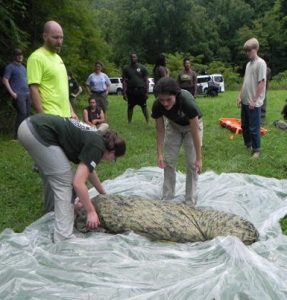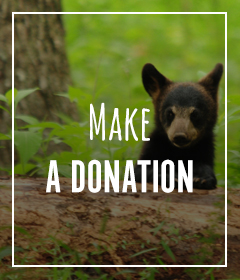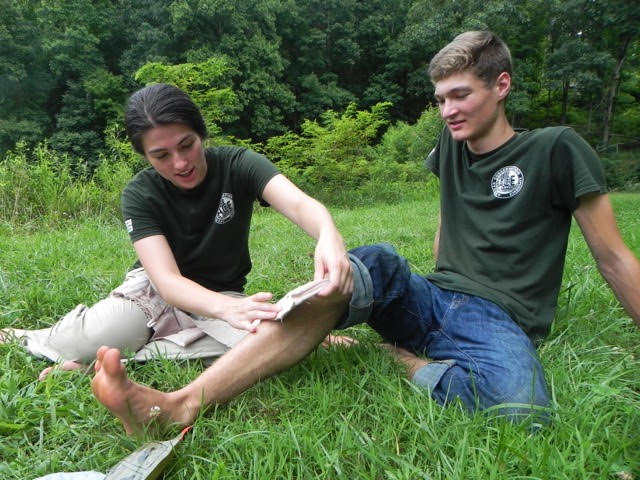Megan Galloway, a high school student at Haywood Early College in Waynesville, North Carolina, participated in the Great Smoky Mountains National Park’s high school internship program for six weeks this past summer. In this post, she shares the events of the day the interns practiced search and rescue strategies, from water rescue to creating a hypothermia burrito wrap.
by Megan Galloway
Haywood Early College – Waynesville, North Carolina
Over the course of the summer my fellow GSMNP interns and I learned many valuable skills and lessons, including how to maintain trails in the park, how to talk to visitors in the park, the basics of Search and Rescue (also known as SAR).
My favorite day on the job was SAR day because we spent the whole day outside, in the water, and we all had lots of fun. We worked with survival expert Andrew Herrington. Andrew taught us all the basics of SAR, and we all enjoyed learning about what Andrew had to say.

The day before Search and Rescue day, our park ranger, Erin Lamm, told us to wear our bathing suits under our clothes, but we didn’t really know why. However, as the day went on, we found out.
The day started off normally, we all loaded up in park vehicles and drove out to Andrew’s property on the edge of the park.
No one really knew entirely what was in store for us that day because it was all up to Andrew.
When we got out of the cars, Andrew said, “Hi everyone, I’m Andrew Herrington. Let’s all start by taking off our shoes and socks.” It was a little bit of a shock.
Stretching and crawling to improve mobility
We all did as he said and then took a seat in the grass, we introduced ourselves and then we jumped right into stretches. The stretches that we did are designed to help with mobility and keep the human body working in the proper ways.
We also practiced crawling. We did a standard crawl (hands and knees), a bear crawl (hands and feet with your back as flat as possible) and an army crawl (on elbows and knees as close to the ground as you can get). These crawls also were to help with mobility.
After quite a bit of stretching and crawling, we all got some water and Andrew started talking about his SAR team. He explained that in many situations you have a person, or many people, who are either injured or unconscious and you and your team will have to find a way to get them out of a dangerous place.
SAR is very important because it is used when someone has gone hiking and goes missing or there’s an emergency situation where people are in grave danger, and they need help by trained professionals. Being on a SAR Team is stressful and lots of hard work, but it was really cool to see how it works.
Practicing carrying victims
Andrew used some of us as examples and showed how to safely carry people using the fireman’s carry (or over the shoulder carry), the two-man carry, the three-man carry, and the four-man carry. After he taught us how to safely do those, we got to practice them on our fellow interns.
He split us into two groups, one group laid on the ground and the other group was the rescuers. The objective was to carry every person to the safe zone as quickly and efficiently as possible. I thought this exercise was very fun.
When we finished the carry exercise we practiced our balance by doing some exercises on a two-by-four, where many of us learned that we need to work on our balancing skills.
We all took a nice break, ate some well-needed lunch and Andrew showed us many of the helpful tools he carries in his pack to aid him in Search and Rescue situations. After lunch, we learned how to use a pressure bandage, how to make a splint, and how to set up a “hypothermia burrito wrap.”
Hypothermia burrito wrap
You use a hypothermia burrito wrap in a case where you find someone who is hypothermic. The first step is you first need to get them to a safe space.
All the members of Andrew’s search and rescue team carry the things needed to make a hypothermia burrito wrap — a large sheet of plastic (or a tarp), some type of padding for the person to lay on, two trash bags, and a blanket or sleeping bag.
When you make a hypothermia burrito wrap, you lay the plastic on the ground, put the padding on top of the plastic, and place the person on the padding. Next, put one trash bag (with a hole at the top) over the person’s head, and then put their legs in the other trash bag so they are wrapped in the trash bags. Then cover them in the blanket or sleeping bag and wrap the plastic around the person to swaddle them. You have now successfully made a hypothermia burrito wrap.
If you’re questioning the effectiveness of this technique, I can speak from experience that it will heat you up very quickly. I volunteered to be the victim when Andrew was demonstrating this technique. The hypothermia burrito wrap is an effective way to increase a victim’s body temperature quickly.
Finally, Andrew instructed us to jump in the lake, and we figured out why we needed our bathing suits. This was my absolute favorite part of the day because the water was warm, and we were all just having so much fun learning in the water.
Using ropes for water rescues
Andrew told us that in order to be a lifeguard you have to be able to tread water for 10-15 minutes, but he wasn’t going to make us do that. Instead we practiced treading water for 5 minutes, but some of us (myself included) treaded water for the entire 10 minutes. After that, we learned how to throw ropes to help people in a situation where we couldn’t get in the water.

When everyone had thrown ropes, we practiced a shallow water entry. Shallow water entry is the technique rescue swimmers use to enter the water in a fast, efficient way to get to the person in danger.
A shallow water entry is basically a shallow dive, and it is used in water rescue because it allows the rescuer to keep their eyes on the victim.
Andrew then showed us the best way to deal with a panicked swimmer.
He asked for volunteers to do a “rescue.” Another intern, Stuart, and I volunteered. We rescued our ranger, Erin, twice, once without a rope attached to our backs and once with a rope.
We did one rescue with a rope and one without to help us understand what a water rescue would be like in different situations. We were timed. It was a really fun activity because we got to be in the water, and we were also learning a lot.
Simulated rescue situation
Afterwards we were divided into teams and instructed to walk away from the area we had been working in. Once out of sight from the lake, our teams were told to choose a team leader and a swimmer, my team chose me to be both the leader and the swimmer. We also chose a backup swimmer, Cailyn, in case we needed one.
We were team one and went first. We didn’t know if we were timed or not. So we ran to the water, and I immediately put on a lifejacket.
Andrew said that Erin (our victim) had been in the water for a while, and she didn’t know how to swim so we, as a team, had to save her. My team and I decided that Erin was out too far from the shore for one rope to reach, so we tied two ropes together.
I jumped in the lake, swam to Erin, and began pulling her to shore. She told me she was cold, so I yelled at my team on land to set up a hypothermia burrito wrap. When we got to the dock, we pulled Erin out of the water and put her in the hypothermia burrito wrap — “saving” her.
Rescue swimming was a really fun exercise that made me consider becoming a rescue swimmer because I enjoyed it so much, and it made me feel good to have the ability to help someone if they were in danger.
Our search and rescue training day was very fun and informative. I truly enjoyed every second of the day and the whole internship. I’m grateful to have had such an amazing experience, and I hope many other people get to experience it as well.
***
This is the third post by students who participated in the Great Smoky Mountains National Park Summer Internship Program this year. The students represent high schools in North Carolina and Tennessee that are near Great Smoky Mountains National Park.
Stuart Hemmer-Skidmore wrote a post introducing the program.
Lorein Helm wrote a post about working with GSMNP fisheries staff to survey fish in the park.
The program is designed to give the interns a little taste of a variety of activities that rangers are involved with – from fisheries science to botany to forest and stream ecology. The interns gain an understanding of how the park is managed and are introduced to possible career opportunities.
This summer, nine students from North Carolina and five from Tennessee participated in the program. North Carolina also had three interns working with Asheville Greenworks who joined the high school intern program in the Smokies on Mondays and Tuesdays. The addition of the Asheville Greenworks interns was sponsored by FOTS.
GSMNP staff involved with the program included Erin Lamm, who supervised the North Carolina interns, Julianne Geleynse, who supervised the the Tennessee interns, Max Lanning, who worked as a Teacher in Parks, Joéle Emma, Director of Education at Asheville Greenworks, and Susan Sachs, Nigel Fields and the Park Administration, who supported the program.
 Erin Lamm provided the photographs for the interns’ posts.
Erin Lamm provided the photographs for the interns’ posts.
FOTS helped support the program for 16 years, initially providing the salaries for the interns and then funding the program staff salaries. To help support programs like this, you can make a donation online.
